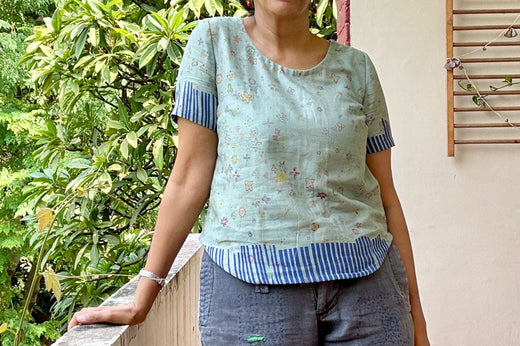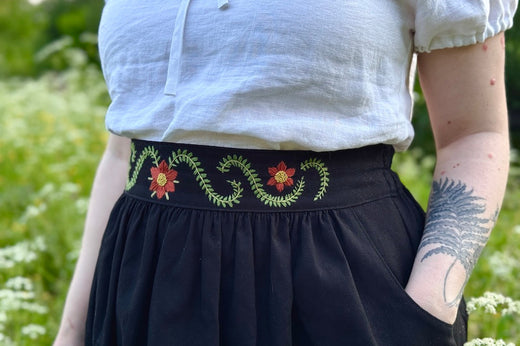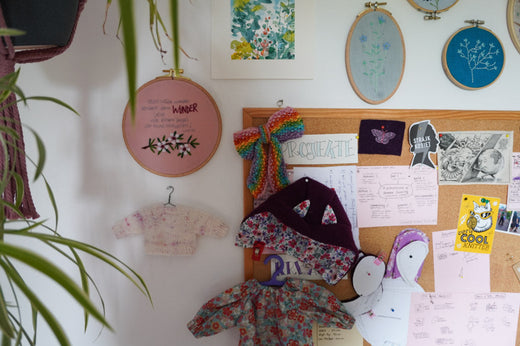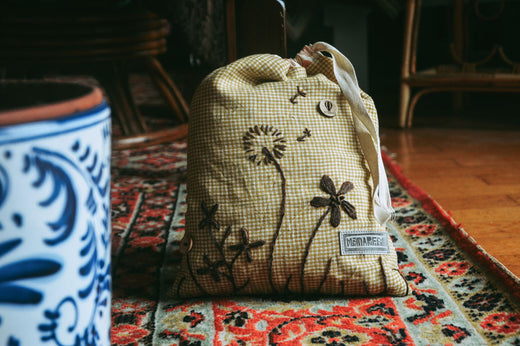It's no secret that we're big fans of upcycling at Twig + Tale - our patterns include an upcycle guide with ideas for transforming used textiles into handmade garments. Ultimately, repairing and upcycling can keep textiles in use for longer, and prevent them from ending up in a landfill.
Upcycling often requires a different approach than sewing with yardage. While there can be some problem-solving and planning required, upcycling can also be a satisfying creative challenge. If you're interested in giving it a go, here are some of our favourite tips.

Planning
Take some time to consider how you plan to use an upcycled textile. In some cases, it may be most efficient to open up the garment along the seams to lay it flat before cutting out the pattern pieces. Other times, you may want to reuse features of the original garment, such as seams, pockets, or hems. With some careful and creative planning, you can use original features to create something truly unique.
For this Animal Coat, Wietske upcycled an adult-sized wool jacket, carefully reusing elements such as the back seaming, pockets, and trim:

"When upcycling, I find it especially important to plan before cutting. You don’t have infinite yardage to work with and there’s no going back to the store for more. I lay out my largest and most crucial pattern pieces first. As I usually have to rearrange many times, it is sometimes easier to print an extra copy of pattern pieces that need to be cut as multiples. After ensuring that I can cut the largest pieces, I then move on to the smaller ones. I sometimes need to supplement with another fabric, or seam together two smaller pieces, or improvise my plan (have a less gathered skirt for example) to make it work, but careful cutting gives me the maximum amount of usable fabric. Along with this, I’d also note that non-directional fabrics yield more possibilities for pattern placement." (Christen)
"My favorite upcycling tip - reuse those hems! To reuse them, and maintain the correct length of the garment, you’ll want to place the finished hem edge at the hem notches on the pattern. This effectively removes the “extra” length you would normally turn up for a hem, so you are ready to go." (Erica)
"My best tip is to work on upcycling projects when you have the time to relax into them. When I am dismantling one item to cut it into pieces for another item I am more likely to meticulously take out seams and get all the available fabric if I have plenty of time. If I feel rushed I tend to just chop into the fabric and more gets wasted." (Sashanna)
"I like to search out interesting colours and features like belts, buttons, pockets and decorative stitching. I always make sure to break it down only once I've a plan for it taking what I need and then removing and saving the leftovers for another day. Although bigger things are easier to upcycle I love the freedom to browse any size on the rail. There is always a use for everything!" (Lorna)
Mending textiles for upcycling
Sometimes we find a textile that would work well for upcycling in certain ways - for example a nice quality of fabric or interesting details - but it may have holes, damage, or fading. In this case, creative mending techniques or embellishments can be used to salvage fabric and add unique details to your garment. Embroidery, visible mending, and patching are all ways to "fix" holes or worn places in fabric.
Here, Kristin has used our Bee Embroidery to patch a hole in the seat of a favourite pair of pants:

"Holes and stains that cannot be removed or mended in up-cycled fabrics gifts us a wonderful opportunity to be creative and add story to our sewn pieces! I love placing lace, different shaped patches or buttons in these places if I discover them nearing the end of a project...because somehow I've missed that tiny hole while cutting out my pieces." (Circle of Grace)
"I've found needle felting to be an incredible way to mend holes in woolen projects as well as add cute detail which can also be embellished with embroidery. A few nifty ways to replenish your wool felting stash - I use a depiller to remove pilling from garments or use the wool end scraps from knitting. I also use tapestry wool from the op shop for felting and darning/visible mending." (Lucy Boots)
Dyeing fabric is also a great way to give a textile a completely different look, perfect for fabrics that are faded, or just aren't a colour you like. Here, Naomi has used a shibori dying technique to create stunning fabric for Scout Shorts that looks like ripples in water:

Piecing Fabric
Embrace colour-blocking, fabric piecing, and patchwork as a way to upcycle smaller pieces of fabric. If you're short on fabric, don't be afraid to mix-and-match materials to round out your upcycle projects.
Mei created these Shore Pants (adapted to shorts length) from button-up shirts that her husband no longer wears. She carefully planned the patchwork to include a chest pocket and button placket, and used some simple hand-stitching to cover up the marks from where the buttons had been attached:

"Piecing fabric together makes for a great way to upcycle scraps from other projects, or to make use of upcycles that are a bit smaller than what you need. It's a practice that's been used throughout human textile history to aid in fabric economy. I like to use "crumb quilting" methods, which sort of pieces things together at random, but you can use uniform shapes, quilt blocks, and more, or simply sew a small piece where you need it when laying out a pattern." (Erica)
Larger textiles to upcycle
Don't feel like upcycles have to be limited to small garments - items like tablecloths, sheets, blankets and curtains can provide plenty of fabric for child and adult-sized upcycles. Often, a blanket or duvet (doona) cover will yield enough fabric for multiple projects. Some large textiles just keep giving and giving!
Shifara made this Fable Dress from a lovely, soft duvet cover:

"Never say no when friends and family offer fabric - especially cotton doona covers!" (Genevieve)
Upcycling wool
We love sewing with wool, but if can be difficult and expensive to find good quality yardage. Instead, look for used wool blankets, coats, or sweaters. Sometimes, wool will have moth holes, but the fabric can be cleaned and treated to get rid of the moths (and their eggs), and holes can be creatively mended.
If you're interested in felting wool sweaters to sew with, have a look at this blog post.
Emerald created this gorgeous Animal Cape from a thrifted wool blanket:

"My favorite thing to look for at a thrift store is 100% wool! Sometimes you can find old sweaters or blankets. If you find moth holes then there are treatment options. My favorite way to treat moths is to put the sweater in an oven heated to 150F for 2 hours. You can use the wool for mittens, hats, mending other projects, or whatever your heart desires!" Kaitlyn
"Make sure the wool is in a stone pot or plate and doesn’t touch the inside of the oven so it doesn't burn. For European people: put your oven on 100 degrees C, put the wool inside at the same time and keep the wool in the oven for about an hour at 100C. Then put the oven out and let the wool cool down in the oven. Wool shrinks/felts the most from temperature changes and friction and wringing." (Addy)

We hope that these tips give you some guidance and inspiration for giving upcycling a try! Not only is it a great option for those interested in sustainable sewing, but it also poses satisfying creative challenges.
Read more about upcycling here:
- How to felt and sew with wool sweaters
- How to make bias tape from an upcycled dress shirt
- Upcycle inspiration for Pathfinder Vests
~Images by Lorna Parker, Wietske Ossendorf, Kristen Bedell-Hustedt, Naomi Radunovic, Chiew Mei Law, Shifara Shakeel, and Emerald Windsor ~





